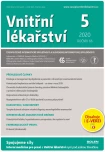-
Medical journals
- Contact
An incidental finding of pheochromocytoma in a 33-year-old patient with Lynch syndrome
Authors: Emília Mojtová 1; Jana Hanajíková 2; Olívia Hamidová 3; Gabriel Bognár 4; Daniel Dyttert 5; Marianna Grigerová 1; Štefan Kečkéš 6; Ján Podoba 1
Authors‘ workplace: Klinika endokrinológie LF SZU a OUSA, Bratislava 1; II. rádiologická klinika LF UK a OUSA, Bratislava 2; Klinika lekárskej genetiky, OUSA Bratislava 3; Ústav patológie LF SZU a OUSA, Bratislava 4; Klinika onkologickej chirurgie LF UK a OUSA, Bratislava 5; Oddelenie imunodiagnostiky OUSA a Vysoká škola zdravotníctva a sociálnej práce sv. Alžbety, Bratislava 6
Published in: Vnitř Lék 2020; 66(5): 80-84
Category: Case Report
Overview
Pheochromocytoma is a catecholamine-producing neuroendocrine tumor arising from chromaffin cells of the adrenal medulla. The detection of these tumors is extremely important because they are associated with high cardiovascular morbidity and mortality. Progress in molecular genetics has revealed that up to 35% of pheochromocytomas are inhereted. Lynch syndrome (hereditary nonpolypous colorectal cancer – HNPCC) is an autosomal dominant genetic condition that is associated with a high risk of colorectal cancer or other extracolonic tumors (adenocarcinoma of endometrium, stomach, ovarian carcinoma, carcinoma of urinary tract, small intestine, brain tumors and skin cancer). Foreign medical journals are reporting an increasing number of cases on coexistence of HNPCC and neuroendocrine tumors, including pheochromocytoma. It increases the likelihood that this type of tumor could represent an additional extracolonic manifestation of Lynch syndrome.
Keywords:
pheochromocytoma – Lynch syndrome – extracolonic manifestation
Sources
1. Zelinka T, Widimský J. Pheochromocytoma – Why is its early diagnosis so important for patient? | Feochromocytom – Proč je jeho časná diagnóza pro pacienta dôležitá? Vnitř Lék., 2015; 61 (5) : 487–491.
2. Pacák K, Lazúrová I. Endokrinní nádory nadledvin v současné klinické praxi. Galen; 2011 : 240 s.
3. Amar L, Bertherat J, Baudin E, et al. Genetic testing in pheochromocytoma or functional paraganglioma. Journal of Clinical Oncology, 34, 2005; 34 : 8812–8818.
4. Martucci VL, Pacak K. Pheochromocytoma and Paraganglioma: Diagnosis, Genetics, Management and Treatment. Curr Probl Cancer, 2014; 38 : 7–41.
5. Jochmanova I, Wolf KI, King KS, et al. SDHB ‑ related pheochromocytoma and paraganglioma penetrance and genotype‑phenotype correletions. J Cancer Res Clin Oncol, 2017; 143 : 1421–1435.
6. Costa MHS, Ortiga‑Carvalho TM, Violante AD, et al. Pheochromocytomas and paragangliomas: clinical and genetic approach. Frontiers in Endocrinology. 2015, 6 : 1–9.
7. Lenders JWM, Eisenhofer G, Mannelli M, et al. Phaeochromocytoma. Lancet 2005; 366 : 665–675.
8. Jochmanová I, Lazúrová I. Diagnostika a manažment metastatického feochromocytómu a paragangliómu. Vnitř Lék, 2017; 63(9): 580–588.
9. Lenders JWM, Duh QY, Eisenhofer G, et al. Pheochromocytoma and Paraganglioma: An Endocrine Society Clinical Practice Guideline. J Clin Endocrinol Metab, 2014; 99 : 1915–1942.
10. Závodná K, Vávrová Ľ, Hamidová O. Diagnostika pacientov s Lynchovým syndrómom. Onkológia, 2017; 12(6): 414–420.
11. Ilenčíková D, Bartošová Z, Babál P. Lynchov syndróm – novinky v diagnostike a liečbe. Onkológia, 2010; 5 (2): 70–77.
12. Perrier RL, Van Galen P, Pasieka JL, et al. An unusual tumor spectrum in Lynch syndrome caused by MSH6 mutation. Hereditary Cancer in Clinical Practice. 2010; 8 : 17.
13. Riff BP, Katona BW, Wilkerson M, et al. HNPCC‑associated pheochromocytoma: expanding the tumor spectrum. Pancreas 2014; 44 : 676–678.
14. Kaur RJ, Pichurin PN, Hines JM. Adrenal Cortical Carcinoma Associated With Lynch Syndrome: A Case Report and Review of Literature. Journal of the Endocrine Society, 2019; 3(4): 784–790.
15. Benjamin G. Challis, Narayanan Kandasamy, Andrew S. Powlson, et al. Familial Adrenocortical Carcinoma in Association With Lynch Syndrome, J Clin Endocrinol Metab. 2016; 101(6): 2269–2272.
16. Young WF. The incidentally discovered adrenal mass. Clinical practice. The New England journal of medicine, 2007; 356 : 601–610.
17. Čtvrtlík F, Tudos Z, Szász P, et al. Characteristic CT features of pheochromocytomas – probability model calculation tool based on a multicentric study. Biomedical Papers, 2019; 163 (3): 212–219.
18. Balogova S, Talbot JN, Nataf V, et al. 18 F‑Fluorodihydroxyphenylalanine vs other radiopharmaceuticals for imaging neuroendocrine tumours according to their type. European Journal of Nuclear Medicine and Molecular Imaging, 2013; 40 : 943–966.
Labels
Diabetology Endocrinology Internal medicine
Article was published inInternal Medicine

2020 Issue 5-
All articles in this issue
- Dyslipidemia in patients with chronic kidney disease: etiology and management
- Transcatheter aortic valve implantation – what do we know in 2020
- Chronic cholestatic liver diseases – Primary biliary cholangitis and Primary sclerosing cholangitis
- Vaccines recommended for diabetic patients
- Ropeginterferon alfa-2 b for the therapy of polycythemia vera
- Alcohol-related liver diseases (ALD)
- Diabetes mellitus and illicit drugs
- Pulmonary‑renal syndrome
- Comparison of different approaches for estimation of prevalence of type 2 diabetes mellitus in the Czech Republic
- Treatement of dyspnea: the cause of troublesome diagnostic process of neurological illness
- An incidental finding of pheochromocytoma in a 33-year-old patient with Lynch syndrome
- Liver transplantation as potential curative method in severe hemophilia A: case report and literature review
- Osteolytic bone lesions, hypercalcemia and paraprotein, but not a myeloma: case report and review of literature
- Praluent (alirokumab)
- Confocal laser endomicroscopy in the diagnostics of esophageal diseases: a pilot study
- Acute limb ischemia due to paradoxical embolism treated with systemic thrombolysis
- Internal Medicine
- Journal archive
- Current issue
- Online only
- About the journal
Most read in this issue- Osteolytic bone lesions, hypercalcemia and paraprotein, but not a myeloma: case report and review of literature
- Alcohol-related liver diseases (ALD)
- Chronic cholestatic liver diseases – Primary biliary cholangitis and Primary sclerosing cholangitis
- Vaccines recommended for diabetic patients
Login#ADS_BOTTOM_SCRIPTS#Forgotten passwordEnter the email address that you registered with. We will send you instructions on how to set a new password.
- Contact

